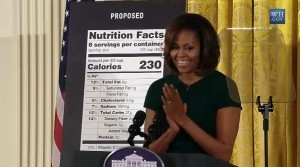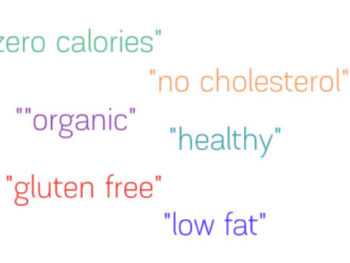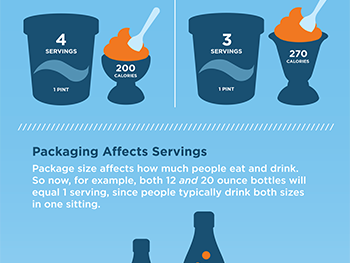Below is my blog for Huffington Post “Larger serving sizes on food labels may encourage us to eat less.”
You can also read it here.
In February 2014, the Food and Drug Administration (FDA) unveiled plans to overhaul the Nutrition Facts panel required on packaged foods in the U.S. Among the proposed updates, FDA plans to revise the serving sizes to reflect more typical serving sizes. Because portions we currently eat are larger than food label serving sizes, consumers may be confused when reading labels and trying to determine ow many calories are in the foods they eat.
Indeed, typical portion sizes available in the marketplace have increased over the past several decades. Should serving sizes on food labels reflect these larger portions?
As FDA states, “These updates would reflect the reality of what people actually eat, according to recent food consumption data. By law, serving sizes must be based on what people actually eat, not on what they ‘should’ be eating.”
While there are clearly advantages to FDA requiring that manufacturers use larger, more realistic serving sizes, unintended consequences may arise. For one, consumers may view food label servings as recommendations even though they are not.
Indeed, according to one study, larger serving sizes may encourage people to eat more.
Now, a new study found that larger serving sizes on food labels will encourage us to eat less and may actually help fight the obesity epidemic.
Researchers from Georgetown University conducted several experiments published in the journal Appetite and found that subjects viewing larger serving sizes on packaged foods thought that they were more representative of typical marketplace portions. The subjects also had a lower health perception of the foods with larger serving sizes on the labels. Finally, subjects shown a larger serving size label ate less than those shown the current serving size label.
The authors wrote, “The studies find that the specific nutrition information provided with foods has a significant impact on perceptions of health, guilt, and estimated caloric intake. Providing consumers with easier to comprehend and more accurate information on all foods served in all contexts could reduce overeating. Decreasing caloric intake, through changing perceptions of health or increasing guilt, could improve public health.”
They concluded that “the proposed increase in serving size on Nutrition Facts panels could lower the consumption of high calorie foods.”
Let’s hope that this occurs in reality if FDA does, in fact, increase the serving sizes on food labels (which the agency proposed doing for nearly 17% of packaged foods).
For example, FDA is proposing to increase the serving size of ice cream from ½ cup to 1 cup. Rather than view the 1 cup serving as a recommendation, I hope that instead, consumers pay attention to the calories and view the larger serving size as a signal to eat less.
Whatever FDA ultimately decides to do, I think it is important that the agency follow up with an education campaign to teach people how to use the serving size information on a label and how to better understand the relationship between serving sizes, calories, and weight gain.
And, I hope that the agency pro-actively address concerns about any possible unintended consequences that some consumers view the serving sizes as recommendations for how much to eat.
As I suggested in my comments to FDA, “I strongly recommend that the FDA include clarifying language on the label by either: 1) denoting the serving size provided as a “typical” serving size or 2) including a footnote to clarify that “the serving size is based upon the amount typically consumed, and is not a recommended portion size.”
While we patiently await the release of the updated food label, I suggest paying attention to how much food is actually on your plate, eating fewer processed foods, and more fruits and vegetables. And, as USDA’s food guide myPlate suggests, fill half of your plate with vegetables and fruit.
After all, no one got fat eating to many carrots.




